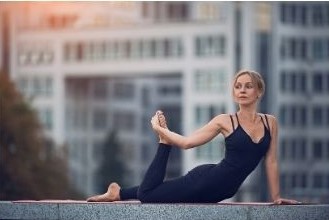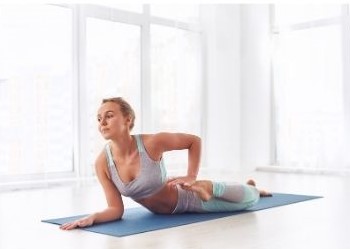Ardha Bhekasana – Half Frog Pose, How To Do, Benefits, Dosha Effects
By Dr Raghuram Y.S. MD (Ay) & Dr Manasa, B.A.M.S
In Ardha Bhekasana the practitioner assumes the shape of half frog or half of that of Bhekasana i.e. frog pose and hence the name. It is a reclining pose.
Ardha – Half
Bheka = Frog
Asana = Pose
Frog pose – It is done from a prone position. From this position the knees are bent, arms reach the back and catch the feet and press them down. The arms are reversed, the elbows point upwards and fingertips downwards. The head and chest are lifted and the performer looks upwards. It opens up the quad and hip flexors and also opens up the chest and improves the posture.
Half frog pose is helpful to open up the shoulders, chest and thighs, all at once. It is also considered to be a deep groin opener pose. It is a deep hip stretch. It provides great relief for those having issues in the back, feet or hips. It may benefit runners, swimmers, students and office workers. It stretches out the hips, quadriceps, feet and back.
Read – Health Benefits Of Yoga: Mind And Body

Table of Contents
Preparation for Ardha Bhekasana
- Done on empty stomach. Early morning is the right time to do it as the stomach is naturally empty during this time.
- If you are performing this asana at some other time you need to have food much ahead before taking to the pose, at least 4-6 hours before the pose. This will keep your stomach empty at the time of taking to the pose and also will give you the energy to do the pose.
- The pose shall be done at evening if you cannot perform it in the day time.
- Bladder and bowel must be empty before starting the pose.
Method of doing
- Lie on your belly.
- Press your forearms against the floor. Your elbows are exactly beneath your shoulders. (You are in Sphinx pose now).
- Lift your head and upper torso gradually off the floor.
- Bring your left forearm inwards while still pressing it against the floor. This gives the needed support for the pose.
- Bend right knee and bring the heel towards right buttock.
- Supporting yourself on left forearm, reach back with right hand and clasp the inner side of right foot.
- Gradually rotate right elbow towards the ceiling.
- Slide your fingers over the top of foot. Curl fingers over the tip of toes. Now your fingers are pointing towards your ankle and wrist is on the toes.
- See that your right palm is pressing the top of right foot.
- Now exhale and press your foot with your hand towards the right butt. Count five breaths.
- Inhale.
- If your flexibility is good, exhale and take the foot to the outer border of your right butt with your hand and press it towards the floor. Count five breaths again.
- While doing so, keep your knee in line with your hip. Feel grounded on your hips. Try not pushing your foot too hard if it is hurting your knee.
- Square your shoulders with the front of the mat. See that you don’t collapse into left shoulder. Press down with your elbow to lift your chest.
- Keep in this position for 30 seconds to 2 minutes or for whatever time you are comfortable doing in.
- This completes one half of the frog pose.
Release from the asana
- Release right foot from the grip of right hand.
- Extend right leg.
- Bring back right upper limb to the point of start.
- Sleep in prone position and relax.
Repeat the entire steps on the left side with support of right forearm.
Read – Sarvangasana – Shoulder Stand Pose, Method, Benefits, Dosha Effect
Related Video
Watch this video to follow the method of doing Ardha Bhekasana
https://www.youtube.com/watch?v=u2nL2f1I7pc
Health Benefits of Ardha Bhekasana
- Provides stretch to the entire front of the body.
- Stretches the ankles, thighs, quadriceps and groins and also deep hip flexors
- Strengthens calves, ankles and hamstrings
- Stretches the abdomen, chest and throat
- Stretches the back muscles and improves the flexibility of the back
- Increases spine flexibility
- Improves body posture by improving the alignment of spinal column
- Reduces back pain
- Rejuvenates knee joints by stretching psoas muscles
- Prepares the body for doing back bending poses
- Highly beneficial for those who have flat feet and restricted from running, dancing and long distance walking.
- Regular practice may decrease the risk of knee injuries. This is due to stretching and strengthening of muscles surrounding the knees. Hence it is good for those who are involved in outdoor sports and activities.
- Stimulates abdomen and organs
- Improves digestion
- Stimulates reproductive organs
- Stimulates thyroid and pituitary glands
- Reduce belly fat
- Relieves stress and anxiety
- Increases blood flow to the uterus and ovaries
- It is good for spleen, liver and kidney
- Increases blood flow
- Relieves symptoms of menopause and cures menstrual cramps
- Effective in osteoporosis and sciatica
- Cures asthma and infertility
- It opens up the front of the body in a deeper way. This in turn provides more space to breathe in the lungs.
- This pose is highly energizing.
Preparatory Poses
- Bhujangasana – Snake Pose
- Setu Bandha Sarvangasana – Bridge Pose
- Supta Virasana – Reclined Hero Pose
- Virasana – Hero / Warrior Pose
- Shalabhasana – Locust Pose
Follow up Poses
- Adho Mukha Shvanasana – Downward Facing Dog Pose
- Garudasana – Eagle Pose
Advanced Poses
- Dhanurasana – Bow Pose
- Kapotasana – Advanced Pigeon Pose
Modifications
Keep a bolster under lower ribs and support the lift of the upper torso.
Press your free forearm on floor in front of the bolster.
Bhekasana – full frog pose (intermediate level), this pose opens up the hips. Here, both knees are bent simultaneously, both feet held simultaneously with both hands and pressed against the butts or the floor or as the flexibility allow one to do.
What time should be spent in the pose while doing Ardha Bhekasana?
Ardha Bhekasana should be done for 5-6 long breaths by beginners or for a time period of 30 seconds to 2 minutes or depending on your capacity to hold on to the pose. Initially it shall be done for a short duration and gradually the time period of performance shall be extended after gaining expertise on the asana.

Impact on Chakras
Ardha Bhekasana is one of the best poses to activate and balance Swadisthana Chakra – sacral chakra or spleen chakra. Therefore it is good for spleen and kidney health.
Read – Chakra – Kundalini: Introduction, Meaning, Types, Location, Ayurveda View
Contraindications, Precautions
Patients suffering from below mentioned conditions should avoid doing Ardha Bhekasana –
- High blood pressure
- Low blood pressure
- Migraine, severe headache
- Insomnia
- Low back injuries, severe back and hip injury
- Neck and shoulder injuries
- Knee or ankle arthritis and injury
- Weak shoulders or low back muscles
- Any recent surgery on back or waist
- Spinal cord disorders
- Diseases of lower vertebrae
- Hernia
Point of caution – Pregnant women should not perform this pose.
Impact of Ardha Bhekasana on doshas and tissues
Impact on Doshas – Ardha Bhekasana helps in balancing all three doshas but mainly balances vata and its subtypes.
Since it balances pituitary and thyroid glands, opens up the lungs and makes breathing easy and also relieves stress and anxiety, the pose balances prana and udana vata and also prana vata-udana vata axis. It stimulates abdominal organs and improves digestion, is good for liver and spleen, hence it is beneficial for balancing samana vata, pachaka pitta and ranjaka pitta. It is highly energizing and hence good for balancing vyana vata. It enhances the functions of ovaries, reduces the symptoms of menopause and menstrual cramps and is good for those suffering from infertility, it balances apana vata. Therefore Ardha Bhekasana is beneficial for all vata subtypes.
Impact on tissues – Since the half frog pose stretches and strengthens the muscles and improves the flexibility of the body and joints of the body, it is beneficial for improving and maintaining the muscle health and also for the channels carrying muscle tissue. Since it enhances blood circulation, it is good for rasa tissue and channels carrying this tissue. Half Frog Pose will help in reduction of fat tissue. Therefore it is beneficial for balancing fat tissue and also for fat carrying channels.
Click to Consult Dr Raghuram Y.S. MD (Ayu)








